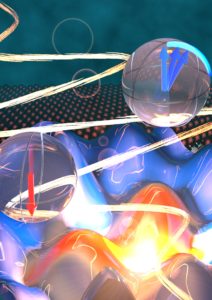Anthony Bloch (Math), Krishna Garikipati (MechE), Vikram Gavini (MechE), Eitan Geva (Chemistry), Bryan Goldsmith (ChemE), Emanuel Gull (Physics) , Manos Kioupakis (MSE), Mack Kira (EECS, Physics), Sandeep Pradhan (EECS) , Liang Qi (MSE), John Schotland (Math, Physics), Kai Sun (Physics), Katsuyo Thornton (MSE), Dominika Zgid (Chemistry), Paul Zimmerman (Chemistry)
Summary (Prepared by Mack Kira)
Michigan has extensive breadth in developing the theoretical basis of important quantum phenomena for a wide range of quantum systems studied by more than 15 faculty in seven different departments (Chemistry, ChemE, ECE, Mathematics, MechE, MSE, Physics). Working on designing and guiding both synthesis and experiments for work in quantum science and technology. The theoretical methodology is based on a first-principles approach to precisely describe the fundamental quantum physics at short time and length scales in semiconductor quantum optics, quantum chemistry, and quantum materials. By combining multiple methods, Michigan has proceeded to scaling-up quantum investigations to reach long time scales and large system size to predict macroscopic quantum effects in diverse systems. The work includes studies of strongly correlated systems, the quantum-classical interface, and dissipation. Additionally, we explore how quantum and classical processing as well as optimization can be implemented at the algorithmic level.
An important theory direction for Michigan is to further develop hybrid theory approaches that can realistically predict quantum processes among strongly correlated electrons, molecules, BECs, and clusters as a resource for new types of qubits. The central focus is to determine how to control quantum-information scrambling (quantum coherence), develop novel materials and compounds synthesis (new quantum materials), and create macroscopic quantum effects so that experiments can control quantum phenomena from the atomic scale up. This effort is driven by the desire to create entanglement processing units(EPUs) which provide an unprecedented platform for controlling quantum-information transfer, storage, and sensing – developing true quantum ecosystemsas elements of quantum networks.
The work includes open-ended problems such as developing correlation receptors– a capability to experimentally detect many-body configurations and correlations for the first time in quantum materials. This work will open a completely new way of literally seeing and, thus, intuitively understanding complicated many-body quantum processes driving quantum ecosystems. We also envision approaches that embrace decoherence instead of fighting it. One option is to optimize coherence even when significant dissipation exists. At the same time, seeing only part of correlations may appear as dephasing, and developing correlation receptors may disentangle the illusion of decoherence.

